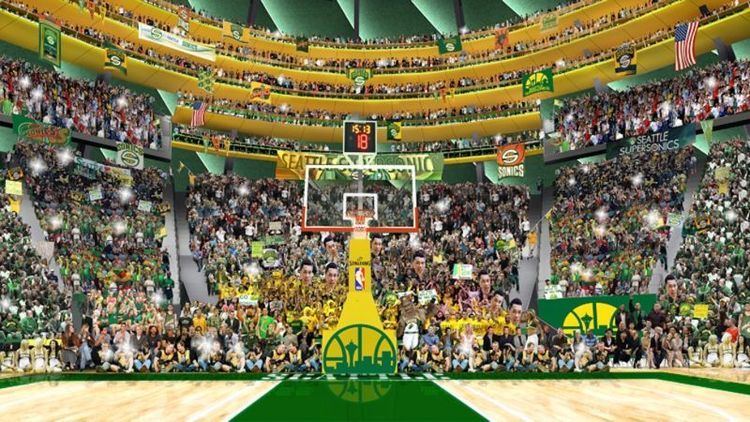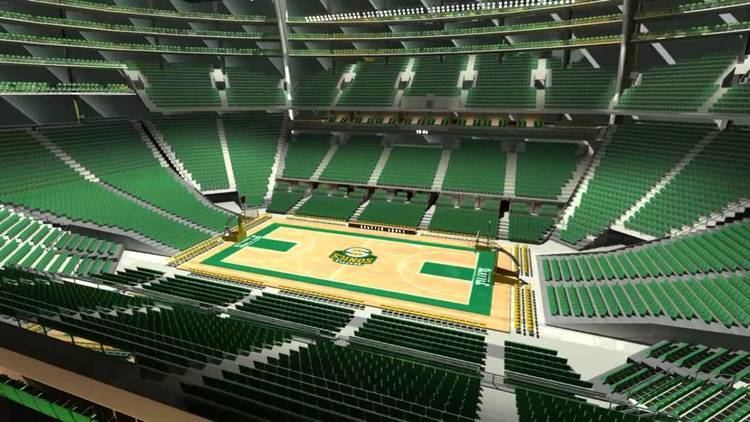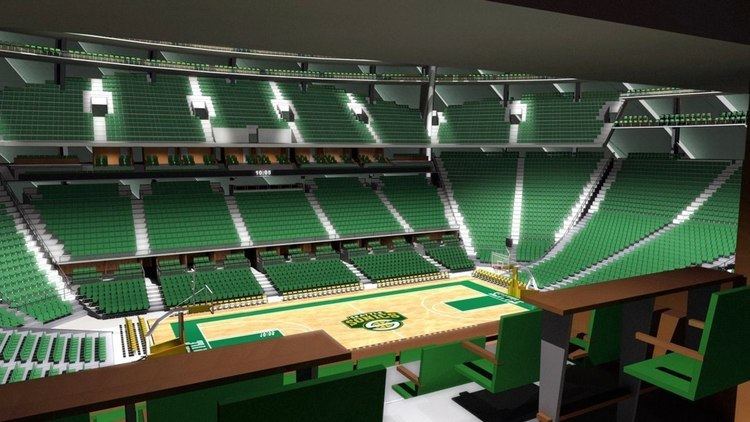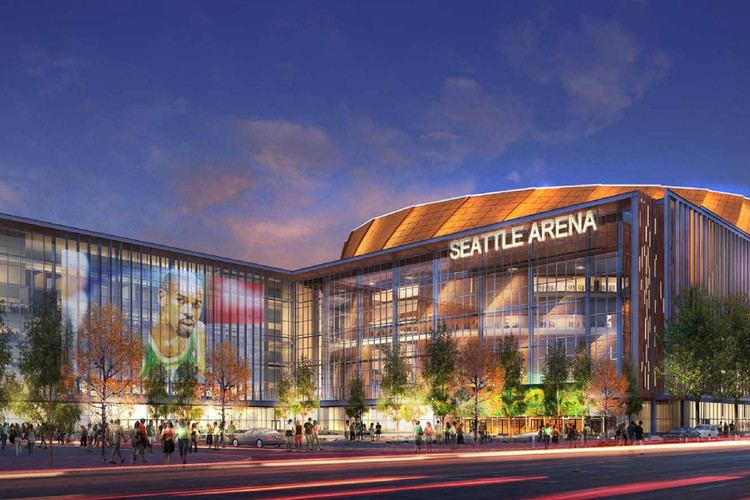Construction cost 550 million USD | Capacity 19,000 to 20,000 | |
 | ||
Address 1700 First Avenue South Similar KeyArena, Safeco Field, Husky Stadium, Benaroya Hall, Northwest Seaport | ||
Sonics Arena is a proposed multi-purpose arena to be constructed in the SoDo neighborhood of Seattle, Washington, United States. The arena would host basketball, ice hockey, and concerts. The proposal calls for an arena with a capacity of around 19,000 to 20,000 seats. It is part of a larger plan to return the Seattle SuperSonics National Basketball Association (NBA) franchise, along with adding a potential National Hockey League (NHL) franchise, to the city of Seattle.
Contents
- Concept rendering of sonics arena
- Background
- Proposal
- Private investors
- Public debate
- Design
- Other Seattle area proposals
- References
Concept rendering of sonics arena
Background

The largest arena by seating capacity in the greater Seattle metropolitan area is KeyArena. Originally called the Seattle Center Coliseum, the arena opened in 1962. It was remodeled and took its present name in 1995. KeyArena was the home of the SuperSonics from 1967 to 2008, the duration of the NBA team's existence in Seattle. The SuperSonics relocated to Oklahoma City, Oklahoma. in 2008 and are currently known as the Thunder.

The KeyArena (then named the Seattle Center Coliseum) was the home of the minor professional Western Hockey League Seattle Totems from 1963 to 1975. KeyArena was later home to the Seattle Thunderbirds of the major junior Western Hockey League from 1977 to 2009. In 2009, the Thunderbirds relocated to the ShoWare Center in nearby Kent. Several professional hockey teams have played in Seattle since 1915. The first was the Seattle Metropolitans, who played in the Seattle Ice Arena from 1915-1924 and became the first American team to win the Stanley Cup in 1917. Other professional hockey teams included the Seattle Eskimos, Seattle Ironmen, Seattle Bombers, and Seattle Americans.

KeyArena's current tenants include the Seattle Redhawks athletic program, the Women's National Basketball Association (WNBA) Seattle Storm, and the Rat City Rollergirls. KeyArena also hosts concerts, circuses, professional wrestling, and other events.

Other arenas in Seattle include the Alaska Airlines Arena at Hec Edmundson Pavilion, home of the Washington Huskies; and Mercer Arena, a performing arts venue. Comcast Arena, in Everett, is the home of the IFL’s Everett Raptors and the WHL’s Everett Silvertips.

A key reason given for the Sonics relocation to Oklahoma City in 2008 was KeyArena’s small size and lack of amenities. Before moving the team, the SuperSonics' ownership group proposed that a new arena be built in Renton using $500 million in public funds, but an agreement was not made. In an attempt to keep the Sonics in Seattle, a group of investors led by former Microsoft CEO Steve Ballmer promised to pay half of the $300 million needed for a proposed remodel of KeyArena (with Seattle and King County financing the other half), but an agreement was not reached.
On January 21, 2013, the Sacramento Kings were sold to a Seattle-based ownership group, on the condition that the NBA Board of Governors approve the sale to San Francisco hedge fund manager Chris Hansen. These reports were by Hansen, the Maloof family, and the NBA. However, on May 15, 2013, the NBA voted 22-8 to reject the Kings' proposed relocation to Seattle. The day after the NBA's decision, the Maloof family reached agreement to sell the Kings to a group led by Silicon Valley tech entrepreneur Vivek Ranadivé for a record NBA franchise valuation of $535 million and the team will stay in Sacramento.
Despite the failed attempt to move the Kings, Hansen's plans to bring an NBA team back to Seattle, possibly by expansion, are continuing.
Proposal
In late 2011, the City of Seattle was approached with a proposal to build a multipurpose arena in an industrial zone south of CenturyLink Field and Safeco Field. The total cost of a new arena had been estimated to be $490 million, and the investment group had proposed a direct public investment of up to $200 million, split between the City of Seattle and King County. The investors had agreed to pay any construction shortfalls and for improvements to KeyArena, which would serve as a temporary home for both a new NBA team and a new NHL team while the arena is being built.
On February 16, 2012 Seattle Mayor Mike McGinn and King County Executive Dow Constantine announced an agreement with the investors. The Mayor and Executive forwarded a memorandum of understanding was forwarded to the Seattle City Council and the King County Council for further review and approval.
On July 30, 2012, the King County Council approved the draft Memorandum of Understanding (MOU) that Chris Hansen, Mike McGinn, and Dow Constantine proposed. Earlier that day the Seattle City Council had declared the MOU unacceptable in its current form with the intent to renegotiate.
On September 11, 2012, the Seattle City Council reached a tentative agreement with Chris Hansen to build a SoDo basketball and ice hockey arena with revisions including the base rent being reduced from $2 million a year to $1 million, some tax revenue paying for surrounding transportation improvements and KeyArena renovations, and an added five-year personal guarantee of bond debts from Hansen.
On September 24, 2012, the Seattle City Council approved the proposed SoDo basketball/ice hockey arena.
On October 15, 2012, the King County Council voted unanimously in favor, while the Seattle City Council voted 7–2 to approve the amended SoDo multipurpose arena proposal.
The Seattle Design Commission approved the project on September 3, 2015. On November 30, 2015 the Seattle Department of Transportation and Mayor Ed Murray recommended that Occidental Avenue should be vacated for the arena. The street vacation was subject to opposition by the Port of Seattle and local longshoreman unions, arguing that Occidental Avenue was a key corridor for freight trucks and would bring gentrification to SoDo and undermine an "industrial working waterfront". On May 2, 2016, the Seattle City Council voted 5–4 against the street vacation and sale of the street. Hansen said the following day in a statement that he and his group would "need to take a little time to step back and evaluate [their] options." Mayor Murray later said that the vote made it "less likely that the NBA will return to Seattle."
On October 25, 2016, in a letter to Seattle Mayor Ed Murray, King County Executive Dow Constantine and the Seattle City Council, Hansen's group offered to terminate the MOU and waive the requirement for the City and County's $200 million contribution (bonds which would have been repaid pay through rent and taxes generated by arena operations). Instead, the group would pay for the entire cost of construction and contribute to other traffic and freight mobility improvement projects, including the Lander Street Overpass, in exchange for the vacation of Occidental Avenue, a waiver on admission taxes similar to that granted to the other sports venues, and a reduction of the B&O tax rate on out-of-town revenue.
Private investors
The primary investor for the project is Chris Hansen. Hansen had a modest upbringing in Seattle’s Rainier Valley neighborhood. He is managing partner of Valiant Capital in San Francisco, where he manages approximately $2.44 billion in public and private investments as of April 2013.
Other investors include Steve Ballmer, CEO of Microsoft; former minor Sonics owner Erik Nordstrom, Executive Vice President and President (Stores) of Nordstrom; and former minor Sonics owner Peter Nordstrom, Executive Vice President and President (Merchandising) of Nordstrom.
Public debate
In early April 2012, the International Longshore and Warehouse Union, Seattle Mariners and Port of Seattle were the first organizations to publicly oppose the arena proposal. All sent strongly worded letters to the city and county arguing the location would negatively impact their business. The Mariners argued that “scheduling, traffic and parking challenges that would likely require hundreds of millions of dollars to mitigate.” The Port raised concerns regarding transportation, infrastructure and land use, and asked for an alternative site analysis.
Approximately 6,000 supporters of the arena proposal rallied at Occidental Park on June 14, 2012. At the two-hour rally, Chris Hansen, Dow Constantine, and other council members spoke along with former Sonics Gary Payton, Shawn Kemp, Slick Watts, and Detlef Schrempf.
On July 7, 2012, the Seattle Times wrote an editorial opposing the arena proposal, writing, “The glittering offer should be turned down with a resolute ‘no thanks.” The paper argued that the location would be too detrimental to the business of Port of Seattle and other companies in the industrial area.
Design
On March 13, 2013, Chris Hansen's group released preliminary design renderings of the arena's interior. Configured to support both basketball and ice hockey, the renderings illustrate two unique seating options. Small sideline "pocket" suites would be less than ten rows from the floor. In the upper tier of the arena, three "Sonic Ring" sections would allow for expanded standing-room seating that could be opened or closed based on event capacity needs. Each ring would feature approximately 800–900 fixed seats and standing-room capacity for between 700 and 1,500 people.
Other Seattle-area proposals
In 2015, two proposals from other groups interested in both basketball and hockey proposed new arenas in the suburbs of Tukwila and Bellevue in light of delays in the approval of the SoDo arena.
